
Litter box training is an essential part of raising a happy and healthy cat. Whether you’re bringing home a new kitten or helping an older cat adjust to a new environment, understanding the basics of litter box training can make the process smoother for both you and your feline friend. Cats are naturally inclined to bury their waste, which makes litter box training relatively straightforward. However, there are several factors to consider, such as the type of litter box, the location, and the litter itself, to ensure your cat feels comfortable and confident using it. In this article, we’ll explore practical tips and tricks to help you successfully train your cat to use the litter box, address common challenges, and create a stress-free experience for your pet.
By the end of this guide, you’ll have a comprehensive understanding of how to set up and maintain a litter box that meets your cat’s needs. From choosing the right litter box to troubleshooting behavioral issues, we’ll cover everything you need to know to make litter box training a success. Let’s dive into the details and ensure your cat has a clean, comfortable, and inviting space to do their business.
Understanding Your Cat’s Natural Instincts
Cats are naturally clean animals with strong instincts to bury their waste. This behavior stems from their wild ancestors, who buried their feces to avoid attracting predators or alerting prey. Understanding this instinct is key to successful litter box training. When you provide a litter box that mimics the conditions cats prefer in the wild, you’re more likely to encourage consistent use.
However, not all cats are the same. Some may have specific preferences when it comes to the type of litter, the size of the box, or even the location. Paying attention to your cat’s behavior and preferences can help you tailor the litter box setup to their needs. For example, some cats prefer a quiet, private location, while others may feel more comfortable in an open area where they can keep an eye on their surroundings.
Choosing the Right Litter Box
The first step in litter box training is selecting the right litter box. There are several types of litter boxes available, including open trays, covered boxes, and self-cleaning models. Each type has its pros and cons, and the best choice depends on your cat’s personality and your household’s needs.
Open litter boxes are the most basic and widely used. They are easy to clean and provide good ventilation, which can help reduce odors. However, some cats may prefer the privacy of a covered litter box, which can also help contain litter scatter. Self-cleaning litter boxes are a convenient option for busy pet owners, but they can be noisy and may intimidate some cats.
When choosing a litter box, consider the size of your cat. The box should be large enough for your cat to turn around comfortably and dig without feeling cramped. For kittens, start with a smaller box and upgrade as they grow. If you have multiple cats, it’s generally recommended to have one litter box per cat, plus an extra one to prevent territorial disputes.
Selecting the Right Litter
The type of litter you choose can have a significant impact on your cat’s willingness to use the litter box. There are various types of litter available, including clumping, non-clumping, silica gel, and natural options like pine or corn. Each type has its advantages and disadvantages, so it’s important to experiment and find the one your cat prefers.
Clumping litter is popular because it’s easy to scoop and helps control odors. However, some cats may not like the texture or the dust it produces. Non-clumping litter is less messy but may require more frequent changing. Silica gel litter is highly absorbent and long-lasting, but it can be expensive. Natural litters are eco-friendly and often have a pleasant scent, but they may not control odors as effectively as other types.
When introducing a new litter, do so gradually by mixing it with the old litter to help your cat adjust. Avoid scented litters, as the strong fragrance may deter some cats from using the box.
Finding the Perfect Location
The location of the litter box is just as important as the box itself. Cats prefer a quiet, low-traffic area where they can do their business without being disturbed. Avoid placing the litter box near loud appliances, such as washing machines or dryers, as the noise can scare your cat.
It’s also important to keep the litter box away from your cat’s food and water bowls. Cats are naturally clean animals and may avoid using a litter box that’s too close to their eating area. If you have a multi-level home, consider placing a litter box on each floor to make it easily accessible for your cat.
Introducing Your Cat to the Litter Box
When bringing a new cat or kitten home, introduce them to the litter box as soon as possible. Place your cat in the box and let them explore it at their own pace. You can gently scratch the litter with your fingers to show them what it’s for, but avoid forcing them to use it.
For kittens, you may need to place them in the litter box after meals or naps, as these are times when they’re most likely to need to go. Praise and reward your cat with treats or affection when they use the litter box correctly to reinforce the behavior.
Maintaining a Clean Litter Box
Cats are more likely to use a clean litter box, so regular maintenance is essential. Scoop the box at least once a day to remove waste and clumps, and replace the litter entirely every one to two weeks. Wash the litter box with mild soap and water during each litter change to keep it fresh and hygienic.
If you notice your cat avoiding the litter box, it could be a sign that it’s not clean enough. Some cats are particularly sensitive to odors and may refuse to use a dirty box. Using a litter mat underneath the box can help contain litter scatter and make cleanup easier.
Troubleshooting Common Issues
Even with the best setup, you may encounter challenges during litter box training. One common issue is inappropriate elimination, where your cat urinates or defecates outside the litter box. This behavior can be caused by medical issues, stress, or dissatisfaction with the litter box setup.
If your cat suddenly stops using the litter box, the first step is to rule out any underlying health problems by consulting your veterinarian. Once medical issues are ruled out, consider whether there have been any changes in your cat’s environment, such as a new pet, a move, or a different type of litter. Addressing these factors can help resolve the issue.
Another common problem is litter box aversion, where your cat refuses to use the box altogether. This can be caused by a dirty box, an unpleasant litter texture, or an unsuitable location. Experiment with different types of litter and box setups to find what works best for your cat.
Read More: Why Do Cats Knead : 12 Reasons Why Your Cat is Making Biscuits
Conclusion
Litter box training is a crucial aspect of cat ownership that requires patience, understanding, and attention to detail. By choosing the right litter box, selecting the appropriate litter, and maintaining a clean and inviting environment, you can ensure your cat feels comfortable and confident using their designated space. Remember to observe your cat’s behavior and preferences, as these will guide you in creating the ideal setup.
With the tips and tricks outlined in this article, you’ll be well-equipped to tackle any challenges that arise during the litter box training process. By fostering a positive and stress-free experience, you’ll strengthen the bond with your feline companion and create a harmonious living environment for both of you.
FAQs
1. How many litter boxes should I have for multiple cats?
It’s recommended to have one litter box per cat, plus an extra one. This helps prevent territorial disputes and ensures each cat has access to a clean box.
2. What should I do if my cat stops using the litter box?
First, rule out any medical issues by consulting your veterinarian. Then, evaluate the litter box setup, cleanliness, and location to identify potential causes.
3. Can I use scented litter for my cat?
It’s best to avoid scented litter, as the strong fragrance may deter some cats from using the box. Unscented litter is usually a safer choice.
4. How often should I clean the litter box?
Scoop the litter box daily to remove waste and clumps, and replace the litter entirely every one to two weeks. Regular cleaning is essential to keep your cat happy.
5. What type of litter is best for kittens?
Non-clumping litter is often recommended for kittens, as it’s safer if ingested. Once your kitten is older, you can transition to clumping or another type of litter.







